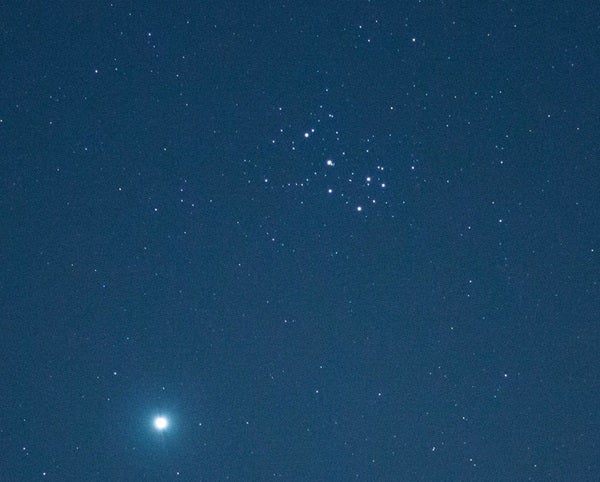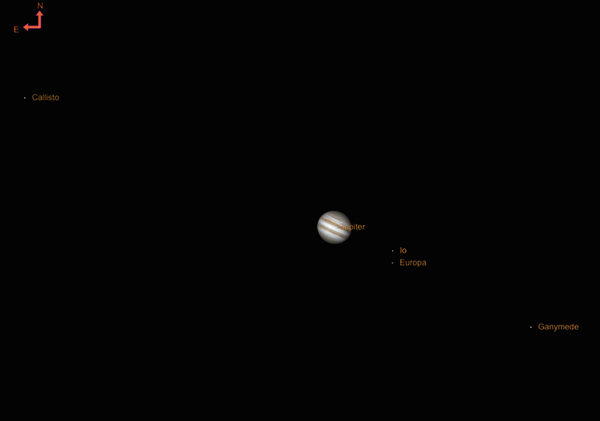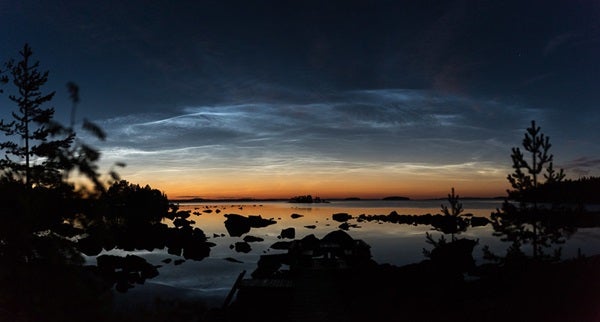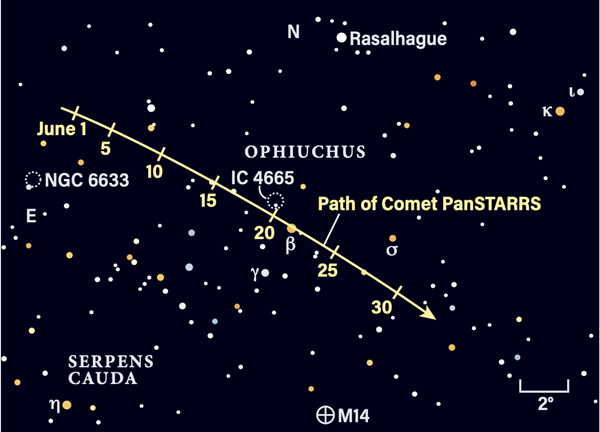Friday, June 24
Following the exciting planetary lineup visible this morning, the Moon passes 0.05° south of Uranus at 6 P.M. EDT (though neither are visible at that time).
After sunset, the dark skies are perfect for galaxy hunting. Let’s focus on a constellation we won’t have available much longer: Leo the Lion. The big cat is heading for the western horizon after dark, but you should be able to squeeze in an hour or two of observing before he disappears.
The most famous group of galaxies in Leo is arguably the Leo Triplet: M65, M66, and NGC 3628. This triad of 9th-magnitude spirals sits just over 7° west-southwest of Denebola, the 2nd-magnitude star marking the tip of Leo’s tail. The three galaxies of the Triplet make a thin triangle, with M65 and M66 forming the east-west base just 0.3° long, while NGC 3628 sits about 0.5° to their north.
But there’s a second trio of 9th-magnitude galaxies you can enjoy within Leo’s bounds as well: M95, M96, and M105. These sit just over 3.5° northeast of magnitude 3.8 Rho (ρ) Leonis and span a larger area, with roughly 1.3° between M95 and M105, which lies to M95’s northeast. M96 is just 0.7° east of M95. In this group, two are spirals — M95 and M96 — while M105 is an elliptical galaxy characterized by its lack of arms and old population of stars.
Sunrise: 5:32 A.M.
Sunset: 8:33 P.M.
Moonrise: 2:35 A.M.
Moonset: 4:44 P.M.
Moon Phase: Waning crescent (17%)
*Times for sunrise, sunset, moonrise, and moonset are given in local time from 40° N 90° W. The Moon’s illumination is given at 12 P.M. local time from the same location.
Saturday, June 25
Hercules the Strongman is high in the east by sunset. Inside this constellation is our target: the planetary nebula NGC 6210.
This magnitude 9.2 nebula, sometimes called the Turtle Nebula, can be spotted from most locations with large binoculars or a small scope. To locate it, find magnitude 2.8 Beta (β) Herculis, then scan 4° east-northeast.
The Turtle rivals M57, the famous Dumbbell Nebula, in brightness. But NGC 6210 is just 48″ across at its widest point, and it shrinks to an apparent 30″ or so at best through most amateur telescopes. Still, it won’t appear exactly starlike — instead, according to Astronomy columnist Stephen James O’Meara, it will look like a swollen star seen through poor atmospheric conditions. What you’re actually seeing, though, are shells of gas and dust ejected by a dying Sun-like star.
For those in or near the Washington, D.C. area, the annual Astronomy Festival on the National Mall event is tonight. This free public outreach event runs from 6 P.M. to 11 P.M. EDT between 3rd and 4th Streets, SW, across from the National Museum of the American Indian. There will be telescopes for viewing, outreach booths from numerous universities and organizations, and scientists available to answer questions and help you explore the night sky.
Sunrise: 5:33 A.M.
Sunset: 8:33 P.M.
Moonrise: 3:02 A.M.
Moonset: 5:47 P.M.
Moon Phase: Waning crescent (10%)
Sunday, June 26
The Moon passes 3° north of Venus at 4 A.M. EDT, shortly before the pair rises in most locations across the U.S. An hour later, both have breached the horizon in the Midwest, sitting among the stars of Taurus the Bull. The two are now closer together — about 2.5° — and our satellite has slid slightly northeast of the planet, appearing to its upper left. The nearly 27-day-old Moon is nearing New, now just 7 percent lit. Venus, meanwhile, shows off an 85-percent-lit crescent through a telescope, its disk some 12″ across.
Less than 7° above Venus is the Pleiades open star cluster, also cataloged as M45. This beautiful group of young stars is often mistaken for the Little Dipper because its components appear to some as a compact dipper shape. However, the true Little Dipper asterism is part of Ursa Minor in the north.
Another hour later, Mercury has risen in the Midwest (it’s already daylight on the East Coast) and once more, all five naked-eye planets stand in order from the Sun in the eastern sky. Enjoy this stunning and rare lineup as long as you can; we’ll lose it early next month as Mercury drops out of sight.
Sunrise: 5:33 A.M.
Sunset: 8:33 P.M.
Moonrise: 3:33 A.M.
Moonset: 6:48 P.M.
Moon Phase: Waning crescent (5%)
Monday, June 27
The Moon, trundling along the ecliptic, passes 4° north of Mercury at 4 A.M. EDT. Two hours later (before dawn in the Midwest but in daylight on the East Coast), the two are slightly closer and the Moon has continued east, now northeast of Mercury (to the planet’s upper left). Our satellite’s barely 3-percent-lit crescent may be a real challenge to spot, so try binoculars or a telescope if you’re having trouble. Take care to put away all observing equipment several minutes before local sunrise in your region, which may differ from the time given below.
Some 7° to Mercury’s upper left (southwest) is Aldebaran, the Bull’s bright red giant eye. This star will likely be one of the last luminaries visible in the approaching dawn. According to star expert Jim Kaler, its name means “the Follower” because it appears to follow the Pleiades through the sky. Aldebaran contains some 1.7 times the mass of the Sun and is 43 times as wide. If placed in the center of our solar system, it would reach halfway to Mercury and appear 20° across in our sky. (The Sun, by comparison, spans 0.5° or so in apparent width — the same as the Moon.)
Sunrise: 5:33 A.M.
Sunset: 8:33 P.M.
Moonrise: 4:09 A.M.
Moonset: 7:48 P.M.
Moon Phase: Waning crescent (2%)
Tuesday, June 28
Neptune stands stationary against the background stars at 7 P.M. EDT. Previously moving northeast along the ecliptic, it will now turn around and swing southwest, moving retrograde until its next stationary point in December.
The ice giant currently rises around 1:30 A.M. local time in southwestern Pisces, near this constellation’s border with Aquarius. To see Neptune’s dim magnitude 7.8 glow, look about 5° due south of Lambda (λ) Piscium with binoculars or a telescope. Thanks to its vast distance from Earth, Neptune appears just 2″ across.
Some 12° east of Neptune is easy-to-spot Jupiter, which shines at magnitude –2.4 and is readily visible to the naked eye, standing out among the faint stars of Pisces and Cetus. The king of planets appears a whopping 40″ across, with three of its four largest moons arrayed to its west (Europa, Io, and Ganymede, from closest to farthest) and one (Callisto) to the east. Io, moving east, passes north of Europa just before 4:40 A.M. CDT, after the East Coast is already bathed in sunlight. After that, Io will move closer to Jupiter, with Europa farther out.
New Moon occurs late tonight at 10:52 P.M. EDT.
Sunrise: 5:34 A.M.
Sunset: 8:33 P.M.
Moonrise: 4:51 A.M.
Moonset: 8:42 P.M.
Moon Phase: New
Wednesday, June 29
The Moon reaches apogee — the farthest point from Earth in its orbit — at 2:08 A.M. EDT. It will then sit 252,637 miles (406,580 kilometers) away.
With no Moon in the sky tonight, conditions could be ripe for spying noctilucent, or night-glowing, clouds. These delicate structures form high in the atmosphere, far above where cumulus or cirrus clouds sit. They are created when ice particles form on high-flying dust and can remain visible long after dark, as the Sun — which is below the horizon from an observer’s point of view — continues to illuminate them.
Displays of noctilucent clouds are difficult to predict, so you simply need to trust your luck and step or look outside frequently after dark to try to catch them. Look toward your northern horizon for bright silvery clouds — those are noctilucent clouds, which will stand out against the background sky. By contrast, “normal” clouds will appear as dark blots because they sit too low to reflect sunlight. Additionally, the later you look, the better, as noctilucent clouds typically appear late at night, around midnight.
Sunrise: 5:34 A.M.
Sunset: 8:33 P.M.
Moonrise: 5:41 A.M.
Moonset: 9:30 P.M.
Moon Phase: New
Thursday, June 30
Ninth-magnitude Comet C/2017 K2 (PanSTARRS) is gliding through the rich constellation Ophiuchus. Already well above the southeastern horizon at sunset, this region is on view all evening, so you can afford to wait for true darkness to fall before you go hunting.
First, locate magnitude 2.8 Cebalrai (Beta Ophiuchi) in the northeastern quadrant of the constellation. Tonight, PanSTARRS is just over 5° southwest of this star. The comet’s white dust tail should now be pointed northward. Several star clusters are nearby, including the 4th-magnitude open cluster IC 4665, which sits just northeast of Cebalrai, and the 7th-magnitude globular cluster M14, just under 6° southeast of the comet.
Sunrise: 5:35 A.M.
Sunset: 8:33 P.M.
Moonrise: 6:35 A.M.
Moonset: 10:11 P.M.
Moon Phase: Waxing crescent (2%)
Friday, July 1
Bright magnitude –3.9 Venus creates a sixth point of light framing Taurus the Bull’s face this morning. An hour before sunrise, the planet stands just over 4° north-northwest of Aldebaran and 1.7° northeast of Epsilon (ϵ) Tauri. The planet continues moving east through Taurus, passing 4° due north of Aldebaran at 8 P.M. EDT.
Also readily visible before dawn this morning is Mars, shining at magnitude 0.4 less than 1° southwest (to the upper right) of 4th-magnitude Omicron (ο) Piscium. Mars will pass just 13′ due south of this star tomorrow morning.
The Red Planet rises around 1:30 A.M. local time — much earlier than Venus — so you can catch it together with Omicron Psc in the still-dark early-morning sky. Through a telescope, Mars now appears 86 percent lit and its disk spans 7″. It will brighten slightly throughout July, though it remains small. Don’t worry, though — by its December opposition, Mars will appear twice as large.
Sunrise: 5:35 A.M.
Sunset: 8:33 P.M.
Moonrise: 7:35 A.M.
Moonset: 10:46 P.M.
Moon Phase: Waxing crescent (6%)














